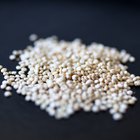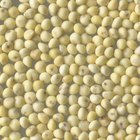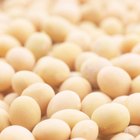
Soybeans are legumes that are rich in nutrients and high in protein. They have very little saturated fats and no cholesterol, making them a good choice for a heart-healthy diet. According the the United Soybean Board's 2010 National Report, 86 percent of people are concerned about the nutritional content of their food and more consumers recognize soybeans as a healthy food.
Green Soybeans
Green soybeans are a special variety that are harvested while still green in the pods. They are sometimes called sweet beans or edamame. You can buy them still in the pod or as shelled green beans. They look like large peas in the pod. They are often boiled for 3 to 5 minutes and served with salt as an appetizer or vegetable. A 1-cup serving has about 22 g protein and 254 calories.
Roasted Soybeans
Roasted soybeans also are called soy nuts. These are soybeans that have been harvested when mature, soaked in water and then baked to become toasted and crunchy. Used mostly as a snack item, they also are a good addition to grains and salads. Sometimes they are flavored with salts and spices. A half cup serving of these soybeans contain about 34 g protein and 388 calories.
Soybean Foods
Soybeans are used to make a variety of foods. Soy milk is made from crushed soybeans and water. Some varieties have added sugar or sugar substitutes and flavorings, such as vanilla or chocolate. One cup of soy milk has 7 g protein and 80 calories. Tofu is made from soybeans and is sometimes called soybean curd. It is made from curdled soy milk and comes in soft, medium and firm varieties. One cup of firm tofu has 52 g protein or about 8 g protein per 100 g tofu. Another soybean food is miso, that is used to make a traditional Japanese soup. Miso is a fermented soybean paste that contains about 11 g protein per 100 g miso. Tempeh is a fermented soybean food that is made from pressing whole soybeans into a cake-like form. This process of fermentation and using the whole soybeans make tempeh higher in protein than tofu. Tempeh has about 18 g protein per 100 g tempeh.
Considerations
Some people have allergies to soybeans and soybean products. Always check with your medical professional before making changes to your diet.
Related Articles

Is Miso Soup Vegan?

How to Soak Amaranth

How to Cook Khus Khus

How to Cook Quinoa Flakes for Breakfast

How to Cook Chicken Cutlets Without ...

How to Cook Millet Meal

How to Eat Buckwheat Raw

Bulgar Wheat Vs. Couscous

What Is White Oat?

What Is Indian Flatbread Called?
Substitutes for Oat Bran

Nutritional Facts of Fava Beans

What Is the Difference Between Rolled ...

How to Cook Oat Groats in a Crock Pot

How to Sprout Soy Beans

How to Cook With Raw Organic Chia Seeds

How Many Calories Are in a Stuffed Bell ...

How to Cook Raw Chickpeas or Garbanzo ...

How to Finely Grind Celtic Sea Salt

How to Season Edamame
References
Writer Bio
Deila Taylor received a bachelor's degree in biochemistry from Occidental College with graduate work towards a Ph.D. in pharmacology and nutrition at the Keck School of Medicine of the University of Southern California. Taylor has written for LoopLane, The Nutrition Counselor, Eve Out of the Garden and produces interviews for The Mormon Women Project. She is a member of the American Society for Nutrition.
Photo Credits
Soy beans on green leaf image by Monika 3 Steps Ahead from Fotolia.com